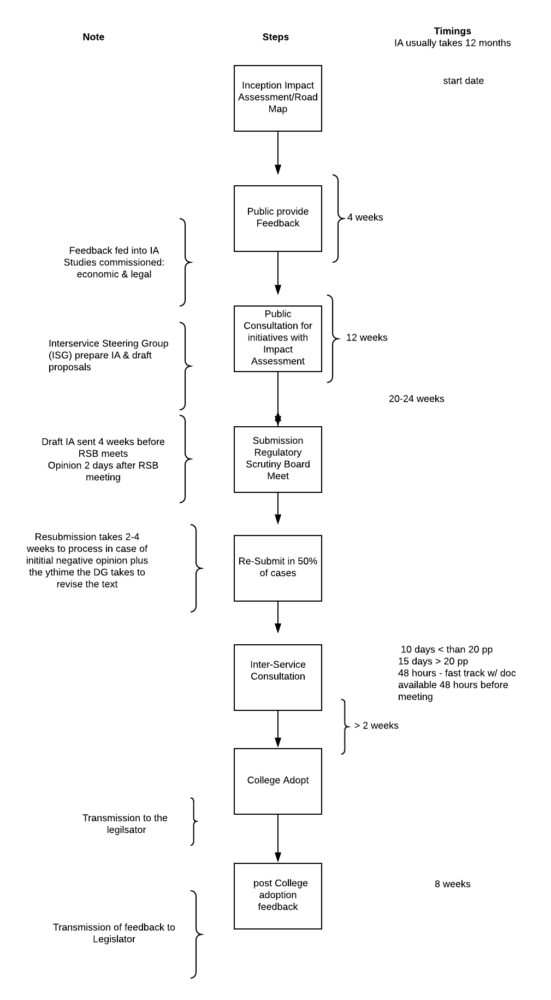Inter-Service Group to Inter-service Consultation
-
Inter-Service Group
An impact assessment is required for Commission initiatives that are likely to have significant economic, environmental or social impacts.
Work for major initiatives can begin once political validation by the First Vice President, Vice President, Commissioner and in close collaboration with the President.
The political validation requirements are below:
The IA is led by the lead DG. The IA is prepared by an interservice group (ISG) which will steer the IA process and collectively prepare the IA report.
Under an earlier version of Better Regulation, the ISG was known as the Impact Assessment Steering Group (IASG) (link).
The Secretariat-General will lead ISG when the item is in (1) the Commission’s Work Programme, or (2) an important initiative, or (3) a sensitive initiative. Otherwise, the lead DG steers with the help of their DGs Impact Assessment unit.
Along with the lead DG, all other relevant DGs will be involved. The relevant policy unit within the Secretariat-General and Legal Service will be present. Additional expertise from other DGs needs to be drawn in, such as as economic analysis (e.g. ECFIN), scientific research and analytical models (e.g. JRC), social impacts (e.g. EMPL), SMEs, competitiveness (e.g. GROW), environment (e.g. ENV), fundamental rights (JUST), innovation (RTD), digital/ICT (CNECT) etc.
Some ISG can be large containing over 40 officials. The benefit of the ISG is that it provides you with a lot of opportunities to provide additional input. This is dependent on you having already provided e substantive submission during the public consultation.
If you choose not to participate in the inception impact assessment or provide little to no supporting evidence to support your case, the chances of you being listened to during the adoption phase are limited.
The quandary is that the impact assessment model is rightly evidence heavy. Data, studies and information are the currency of influence. Many find ‘evidence-based policymaking’ hard to accept beyond slogans.
Too often, weak evidence, conjecture and passing off correlation as causation are exposed. Your weak case is rejected.
Instead of accepting the weak case, many instead choose to attack the impact assessment in self-pitying anguish. It serves no better case than self-prescribed therapy. It changes nothing
Sometimes, the lead DG is unacquainted with the rigour required in preparing an IA. As the exercise is set up to avoid confirmation bias, or writing up the conclusions at the start before any evidence is presented, the file is sometimes handed over the SG to complete.
Preparing a good quality Impact Assessment is not a slight ordeal. Yet, a good quality impact assessment helps strengthen the policy and later on, the political case, for the final proposal.
The process lasts around 12 months and follows these steps.
You can summarise the process like this:

Inter-service Consultation – Political Adoption
After the Impact Assessment is approved by the RSB, it can move from preparation to adoption.
See chart below:
Political Adoption Steps
Fortunately, the Commission spells out the mechanics of adopting proposals clearly. There is a helpful note from the Commission on their ‘Working Methods’. the_working_methods_of_the_european_commission_2014-2019_november2014_en
The adoption procedure is in two distinct steps. First, there is consideration by the Services. The Services are consulted on the draft legal text, the impact assessment together with the opinions of the Regulatory Scrutiny Board.
The second step is the political scrutiny by the Commissioners. Here the College of Commissioners can adopt by the written or the oral procedure.
Adoption by written procedure requires all services to give a positive position during the ISC. Any negative opinions must be lifted via bilateral negotiation for adoption by the written procedure to proceed.
Step 1
The Commission uses an electronic system called “CIS-Net”.
The lead department needs to consult the following:
-
Departments with a legitimate interest in the proposal
The following department usually has to be consulted:
-
Legal Service
-
Sec-Gen
-
Human Resources
-
Budgets
-
OLAF
-
Communications
If the lead Department does not follow the correct procedures, the Sec-Gen can intervene and suspend the procedure until the errors are rectified.
The Departments can say:
-
No Opinion/ No Answer
-
Positive Opinion
-
Positive Opinion with comments
-
Negative Opinion
The lead department then works to incorporate the changes.
Who is involved
Not too many people involved. Those engaged in the proposal come from:
-
Inter-service Group
-
Director Generals
-
Chef de fiche – Cabinet Officials working on the file
-
Heads of Cabinet
-
Commissioners
In practice, you are dealing with around 20 people.
Finding out who follows the file in the Cabinet is easy enough. Their official portfolio is posted on-line. However, double-check that they are still there – there is a high turnover.
On sensitive files, there is a fast track process of 48 hours, where document circulation is limited to a few officials. For particularly sensitive proposals, there is a confidential reading room where officials visit to review the files.
Step 2
When an agreement is reached at the Service level the file is given over to political validation. Most of the time the Commissioners agree with the proposal and there is no disagreement. Rarely there is a vote in the College, but it is very rare. For example, on 6 November 2013 then Commissioner Barnier voted against placing on the market for the cultivation of a maize product Zea mays L.
If they can’t reach an agreement, the Commissioners will go several rounds looking to reach an agreement. After a few rounds, the President’s Cabinet will step in to reach an agreement. Back in August 2009, on Blue Fin Tuna CITES listing, the internal wrangling went on over the summer. The Director-General of DG Environment got annoyed that his Commissioner was ignoring his advice. His Commissioner won the day.
You can find the agenda and minutes of the College meeting at
The minutes are at best opaque. The best sources on what really happens in the College is Politico, the FT, and Liberation’s Jean Quartremer.